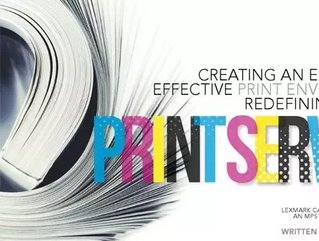Creating an Efficient and Effective Print Environment by Redefining Managed Print Services

Written by Matthew Barnicoat
IT managers can’t get enough of BYOD, cloud computing and everything-as-a-service these days. In fact, they are so busy using these solutions to reduce costs and increase efficiency that they often forget that it’s possible to combat these worries with something as simple as printing.
InfoTrends research shows that organizations spend about three to six per cent of their annual revenues on print-related costs such as copying, faxing and output. These costs can be reduced with managed print services, or MPS, which allows a company to streamline its printing operations by hiring a printing provider to control and optimize the print environment.
But what is MPS, really? The only agreeable definition is that MPS provides consolidated billing, proactive maintenance of equipment and ongoing optimization. Yet, thinking of MPS this way is too simplistic – it’s more than staying on top of toner levels and finding ways to use less paper; it’s about proactively discovering ways to save time and labour and incorporating solutions that make the workforce more productive. So how does it work?
The most important aspect to consider when thinking of MPS is that it is a centrally managed service provided by a printing provider. This means that the print fleet is remotely monitored and any complications that arise are fixed automatically.
In addition to monitoring for any errors, the provider also tracks toner and paper levels, meaning that an organization doesn’t have to worry when it runs out of ink cartridges or letter paper. Even more impressively, printers have become more self-aware so they are able to keep an eye out on their own levels and inform a technician when changes need to be made. Allowing a provider to manage the maintenance process can provide significant cost savings.
Because the entire printing process is monitored, it becomes easy for the provider to offer governance during the print optimization process. For example, it is possible to monitor performance by office, region and location, to tell who in a company is printing the most and how much the fleet is outputting. This allows IT managers to find ways to reduce spending within the printing infrastructure.
The most unique way that MPS can solve printing needs is through the recommendation of software solutions that can streamline printing processes and ease the administrative burden. For example, if a company scans and files similar types of paperwork, the printing provider can recommend a solution that captures the information on the forms automatically, therefore eliminating hours of unnecessary paperwork.
Conducting a print assessment can ensure the success of MPS in a given company. After asking questions such as “How many devices do you have in your fleet” and “How many pages do you print in a month?” the auditor is able to determine how to meet client needs in order to lower overhead. An entire office, not just the IT department, can run more smoothly with the help of MPS.
Even though MPS is not the latest and most flashy option for reducing cost and increasing efficiency – it makes a difference to the bottom line. IT managers should embrace MPS and not let their print fleet fall to the wayside if they are trying to save money and increase productivity.
About the Author
Matthew Barnicoat leads Lexmark Canada’s Global Services division, which helps clients manage their print fleets through innovative solutions and services. Lexmark provides a consultative approach to MPS that encompasses fundamentals, optimization and governance in order to improve overall print efficiency and business process improvement.
- How to Pick a Computer That Fits Your NeedsTechnology & AI
- Symantec Finds Mobile Business Operation Support Growing Amongst IT ProfessionalsTechnology & AI
- High Valued Family Businesses Are Unprepared for SuccessionCorporate Finance
- Ten Tips to Successfully Audit your Internal Business Operations this SpringCorporate Finance






